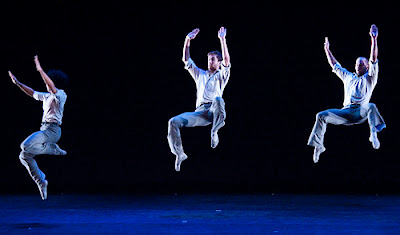LAKE WORTH — Trey McIntyre “gets” it. Not all choreographers do.
But for McIntyre, the music isn’t simply a convenient coat rack, inert and ever-available to hold whatever he drapes on it. He knows and respects the music to a startling degree, whether it’s a children’s song or classical trio, a folksy tune with guitar or elaborately orchestrated rock song.
His contemporary ballets, in effect, are exceptionally musical. They grow out of the music and never seem to depart from it. This quality of McIntyre’s work is so astonishing because it is so rare. Or perhaps it’s more pronounced when illuminated by eight members of the Trey McIntyre Project, a troupe of remarkably beautiful dancers, all classically trained.
The TMP, as it’s called, performed Saturday night to end another year of stand-out modern dance at the Duncan Theatre in Lake Worth. But for this bunch from Boise, Idaho, it’s just the beginning, literally. This is TMP’s debut season as a full-time company. Founded in 2004 as a summer-only touring group, TMP appears more than ready for an inaugural season, complete with the current 30-city U.S. tour, even a short hop to Hungary.
And an auspicious debut it was at the Duncan, but not just for the dancing. Among the three ballets was (serious), given its world premiere less than a month ago. The commission is a major departure a new wave among the choreographer’s more than 70 works.
McIntyre is considered familiar territory around here. Ballet Florida (Second Before the Ground (1996) and Pluck) and Miami City Ballet (The Reassuring Effects of Form and Poetry) perform his works. Even the other ballets on TMP’s Duncan program – Leatherwing Bat (2008) and A Day in the Life (2006) – are grounded in McIntyre’s Midwestern ethic: feel-good, warm and character-friendly. Although contemporary, his ballets are accessible, set to familiar or highly engaging music. In Bat and A Day, the songs frame a story.
(serious) crosses into a new, more abstract zone. A trio of dancers moves together but does not connect emotionally. Instead, they remain anonymous – to the audience and each other. For 14 minutes, they attract and repel more like magnets than characters.
Two men and a woman wear an identical unisex uniform of gray slacks and white long-sleeve shirt (costumes by Sandra Woodall). The corporate image, with its dulling grayness, is the only identity that projects. It seems to restrict the characters’ interactions, dictating a minimum of communication. At the third section of (serious), dancer Brett Perry struggles as if confined to a box, so reduced is the area for his solo.
Yet their humanity is not completely destroyed. Jason Hartley begins with a demeanor and movements suggesting grief and frustration. Yet as a dancer, his inner grounded-ness makes the off-balance poses seem effortless. His unisons with Chanel DaSilva and Brett Perry are so accurate, the three seem to be mentally bonded. Despite difficult, even aggressive partnering, the three are ever a model of physical quietness yet rhythmic precision.
Set to music for violin, cello and piano by Henry Cowell (Trio: Four Combinations for Three Instruments and Trio in Nine Short Movements), the ballet is a marvel of music-to-dance partnering. What you hear in the music is what you see on the stage to an uncanny degree.
Not all is grim and humorless in (serious). Sections could end with surprising, even playful moves, half-exclamation point, half-question mark. In the final section, the three dancers cling together almost compulsively. At the end, they merge tightly together as one, a single statue caught in the freeze-frame lighting.
Leatherwing Bat is much folksier, set to songs by Peter, Paul and Mary. Childhood themes gradually move toward more grown-up concepts, yet there is still a bit of longing for the younger, innocent days in Bat’s 18-minute story line. McIntyre’s often angular, athletic movements can pit the lower half of the body against the upper half; the two can seem pulled in opposite directions. Yet soloist John Michael Schert, also TMP’s executive director, is endearingly lyrical and musical in I Have a Song to Sing, O!
A Day in the Life, set to 11 Beatles songs, is a nostalgic romp, especially in the full-company number Ob-La-Di, Ob-La-Da. The evening’s longest work at 33 minutes, A Day was also the most popular and sealed the deal with the Duncan audience.
Among the best work, credit goes again to Jason Hartley and Brett Perry for the Blackbird duet, and Lia Cirio in Julia. But for the final third of the ballet, it was Hartley who truly left restraint in the wings.
Here is an excerpt from the TMP Website of the Ob-La-Di, Ob-La-Da section of A Day in the Life:
